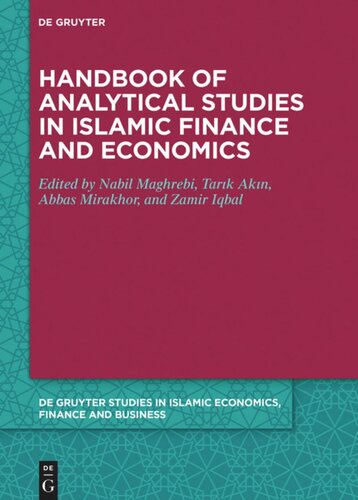

Most ebook files are in PDF format, so you can easily read them using various software such as Foxit Reader or directly on the Google Chrome browser.
Some ebook files are released by publishers in other formats such as .awz, .mobi, .epub, .fb2, etc. You may need to install specific software to read these formats on mobile/PC, such as Calibre.
Please read the tutorial at this link: https://ebookbell.com/faq
We offer FREE conversion to the popular formats you request; however, this may take some time. Therefore, right after payment, please email us, and we will try to provide the service as quickly as possible.
For some exceptional file formats or broken links (if any), please refrain from opening any disputes. Instead, email us first, and we will try to assist within a maximum of 6 hours.
EbookBell Team

0.0
0 reviewsThis handbook offers a unique and original collection of analytical studies in Islamic economics and finance, and constitutes a humble addition to the literature on new economic thinking and global finance. The growing risks stemming from higher debt, slower growth, and limited room for policy maneuver raise concerns about the ability and propensity of modern economies to find effective solutions to chronic problems. It is important to understand the structural roots of inherent imbalance, persistence-in-error patterns, policy and governance failures, as well as moral and ethical failures.
Admittedly, finance and economics have their own failures, with abstract theory bearing little relation with the real economy, uncertainties and vicissitudes of economic life. Economic research has certainly become more empirical despite, or perhaps because of, the lack of guidance from theory. The analytics of Islamic economics and finance may not differ from standard frameworks, methods, and techniques used in conventional economics, but may offer new perspectives on the making of financial crises, nature of credit cycles, roots of financial system instability, and determinants of income disparities.
The focus is placed on the logical coherence of Islamic economics and finance, properties of Islamic capital markets, workings of Islamic banking, pricing of Islamic financial instruments, and limits of debt financing, fiscal stimulus and conventional monetary policies, inter alia. Readers with investment, regulatory, and academic interests will find the body of analytical evidence to span many areas of economic inquiry, refuting thereby the false argument that given its religious tenets, Islamic economics is intrinsically narrative, descriptive and not amenable to testable implications. Thus, the handbook may contribute toward a redefinition of a dismal science in search for an elusive balance between rationality, ethics and morality, and toward a remodeling of economies based on risk sharing and prosperity for all humanity